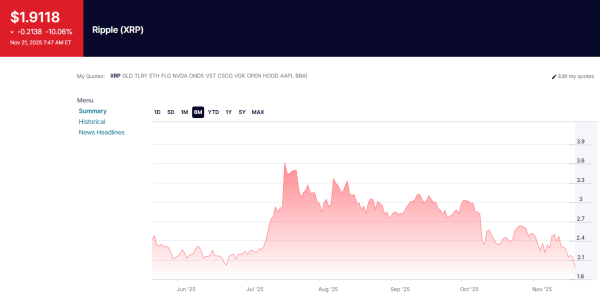Brokers at Nexdi say the crypto market has entered a new chapter in 2025, driven not only by Bitcoin’s institutional surge but now by a major development for XRP that could reshape its long-term value trajectory. The debut of the first U.S. exchange-traded fund tied directly to XRP has opened a gateway for ordinary investors, financial advisors, and institutions who previously avoided the complexities of crypto wallets, exchanges, or private-key management.
With hundreds of millions of dollars flowing into the new XRP ETF on its first trading day, this milestone represents more than a new product launch. It is a structural shift that could strengthen demand, tighten supply, and expand XRP’s role inside the broader financial system.
A Simpler, Safer Way for Investors to Buy XRP
Crypto’s promise has always been paired with complexity. Until now, owning XRP required navigating digital wallets, self-custody options, and transfers between crypto exchanges. The introduction of the Canary XRP ETF (XRPC) changes that dynamic entirely.
A New Avenue for Demand
A spot ETF allows investors to purchase XRP exposure using the same accounts they use for stocks and bonds. This convenience is crucial. Many investors trust their brokerage accounts far more than they trust browser-based crypto extensions. The result is a demand surge that arrived the moment the doors opened.
On its first trading day:
- Roughly 245 million dollars worth of ETF shares were purchased
- Trading volume hit 58 million dollars
This confirms that institutional and retail demand for XRP had been building for years, waiting for an effortless entry point.
Why the ETF Matters for XRP’s Price Dynamics
The key power of a spot XRP ETF lies in its mechanical inflow process. When investors buy ETF shares, the fund must purchase real XRP, removing tokens from liquid circulation and tightening supply. Over time, this supply reduction can drive prices higher if demand continues rising.
Brokers emphasize that ETFs historically accelerate mainstream adoption, allowing advisors, pensions, and institutions to gain exposure without holding tokens directly. This opens XRP to a much broader investor base and introduces a durable, steady source of capital into the ecosystem.
A Practical Bridge for Traditional Institutions
The ETF also solves several long-standing barriers that prevented large players from entering the XRP market:
- Institutional investors can now comply with security-related regulations.
- Advisors restricted from recommending crypto exchanges can now recommend a listed ETF.
- Large capital allocators can scale exposure without operational friction.
Most importantly, ETF inflows create a feedback loop: the more XRP the ETF must acquire, the tighter the available supply becomes in traditional crypto markets.
This tightening effect is similar to what happened with Bitcoin ETFs early in 2024, which contributed to a significant rally. XRP may now experience a more gradual but similar structural support.
Ripple’s Vision: The Long-Term Story Behind XRP’s Appeal
The ETF’s launch comes as Ripple continues developing the XRP Ledger (XRPL) into an enterprise-grade financial network. XRP is positioned as a tool for value transfer, liquidity management, and global payments infrastructure.
XRPL’s Expanding Use Cases
Ripple is building XRPL into a platform capable of supporting:
- Cross-border payments
- Stablecoins issued by financial institutions
- Tokenized real-world assets (RWAs) including bonds, currencies, and commodities
If these initiatives continue to grow, XRPL will require increasing demand for XRP as a settlement asset. As institutions rely more heavily on the ledger for large-scale transactions, they will need exposure to XRP either through tokens or ETFs.
The new ETF has effectively become the bridge connecting traditional finance to this expanding blockchain ecosystem.

A Stronger Ecosystem Means Stronger Long-Term Potential
As XRPL adoption accelerates, network activity and XRP’s real-world utility rise, which typically drives higher demand for the asset. If institutions increasingly rely on XRP for cross-border liquidity or tokenization infrastructure, they may also seek portfolio exposure to its value.
The new ETF makes this transition simple and accessible, allowing traditional investors to gain XRP exposure without using crypto exchanges. Overall, this creates a rare alignment of infrastructure growth, institutional accessibility, and tightening supply dynamics, all of which could significantly strengthen XRP’s long-term outlook.
Should Investors Consider XRP Now?
For those with diversified portfolios who want a measured allocation to crypto, the presence of an XRP ETF adds a compelling new reason to consider the asset. It reduces operational complexity, expands institutional participation, and supports long-term scarcity effects.
Investors can now choose between:
- Buying XRPC for convenience, liquidity, and regulated access
- Holding XRP directly for those willing to manage wallets and custody
Both approaches provide exposure to the same underlying thesis: that XRP’s integration with global financial infrastructure will deepen in the coming years.
With a new ETF funneling capital into the ecosystem, XRP enters 2025 with one of its strongest catalysts to date.








